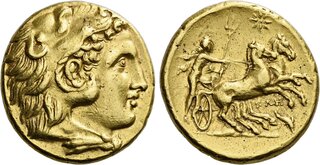| Numismatica Ars Classica > Auction 146 | Auction date: 8 May 2024 |
| Lot number: 2025 Price realized: This lot is for sale in an upcoming auction - Bid on this lot  | Show similar lots on CoinArchives Find similar lots in upcoming auctions on |
| Lot description: Calabria, Tarentum. Stater circa 281-276, AV 18 mm, 8.54 g. Head of youthful Heracles r., wearing lion's skin headdress. Rev. Young man (Taras ?) in prancing biga r., holding trident and reins; above, star and below horses, KΛH / dolphin. Vlasto 18 (this coin). McClean 600 (these dies). Fischer-Bossert G20b (this coin illustrated). Historia Numorum Italy 955. Very rare. A portrait of fine style struck in high relief on a full flan. Extremely fine Ex M&M 68, 1986, 23 and NAC 9, 1996, 34 sales. From the Vlasto and the Athos and Dina Moretti collections. From the Bernalda-Hort hoard (IGCH 1958) It is widely accepted that this stater of Taras was produced during the era of Pyrrhus' intervention in Magna Graecia. The attribution has stood the test of time since Vlasto placed it in c.281 B.C. Current theory holds that the issue belongs either to c.280, as suggested by Rutter, or to the period c.276-272, as favoured by Parente and Fischer-Bossert. For centuries prior to the intervention of Pyrrhus, Rome had expanded its influence throughout Italy. Until the early 3rd Century, Rome's efforts were concentrated primarily in central Italy, with no significant moves being made south of Campania and Samnium. However, in 285 Thurium sought Rome's protection against the Lucanians. Next came requests from Rhegium and Croton, and, in 282, Locri received a garrison of Roman soldiers for protection against the Brettii. Tarentum, however, resisted the temptation for Roman aid. It recognised a trend that eventually would lead to Roman dominion over all Southern Italy. Since 303 Tarentum and Rome had abided to a non-aggression pact, but in 282 the Romans breached the terms when their ships appeared off the Tarentine shore. Some Roman vessels were sunk, which set off a chain of events leading, in 281, to a Tarentine appeal for aid to King Pyrrhus of Epirus. Pyrrhus gathered an army by which he intended to defeat Rome, subdue Southern Italy and, according to Plutarch, conquer Sicily and Carthage. He arrived early in 280 and soon defeated the Romans in a costly battle at Heraclea. In 279 Pyrrhus followed up with a march on Rome, during which he met the Romans in battle at Ausculum. The engagement was so costly that the king could ill afford another 'Pyrrhic victory'. At the end of May, 278, Pyrrhus sailed to Sicily for a new, more promising venture: the defence of Syracuse against the Carthaginians. As Pyrrhus toiled for three fruitless years in Sicily, the Romans continued their efforts to subdue the Greek cities in the South. After the Locrians slaughtered their Roman garrison in 275, Pyrrhus again was invited to Italy. After a brief stay in Locri, the Epirote king made his way to Tarentum, where he prepared to fight the Romans yet again. This time Pyrrhus met the Romans in battle at Beneventum. Just as at Ausculum, despite inflicting great losses on the Romans, the Greeks lost too many soldiers, and Pyrrhus returned to Tarentum. After some months Pyrrhus had lost any interest in waging war on Rome. In the Fall of 275 or early in 274, he extracted himself from the affairs of Magna Graecia. He returned to Epirus and, from there, pursued conquests in Macedon and Sparta, being killed in the latter. Estimate: 25000 CHF |  |



